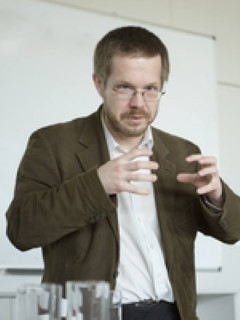This document is unfortunately not available for download at the moment.

Martin Nitsche
Senior researcher and head of the Department of Contemporary Continental Philosophy at the Institute of Philosophy at the Czech Academy of Sciences in Prague.
Associate professor of philosophy at the Jan Evangelista Purkyne University in Usti nad Labem (CZ), Faculty of Philosophy. Vice-president of the Society for Phenomenology of Religious Experience (international, based in Berkeley, USA). Nitsche (1975) received his PhD in philosophy in 2007 from the Charles University Prague. In 2016 he was named an associate professor at the Charles University in Prague (habilitation). 2016/17 he worked as a Fulbright Visiting Researcher at the University of California, Los Angeles, Department of Political Science. His research focuses on phenomenology, phenomenological topology (Heidegger, Merleau-Ponty), philosophy of art, aesthetics, political philosophy, theory of media, phenomenology of religion. Nitsche formulated the "transitive-topological model of phenomenology" (see in his recent book Methodical Precedence of Intertwining. An Introduction to a Transitive - Topological Phenomenology, Königshausen u. Neumann, 2018). He also published Die Ortschaft des Seins. Martin Heideggers phänomenologische Topologie (2013), 3 other books in Czech, and more than 30 papers or chapters. He is the editor of a volume Image in Space. Contributions to a Topology of Images (in a phenomenological series Libri Nigri, Bautz Verlag, 2015).
Methodical precedence of intertwining
an introduction to a transitive-topological phenomenology
Martin Nitsche
The book is a research publication in phenomenology for a wider interdisciplinary (philosophy, psychology, environmental studies, political science, geography, aesthetics) interested audience. It offers a fresh conception of phenomenological philosophy by interconnecting topological approaches of late Heidegger and Merleau-Ponty with transitive thinking that can be found in Husserlian, Jamesian, Schützean, and Gurwitschian notion of the stream of consciousness. To clarify the linkage between a stream and an environment, the book also employs methods used in theoretical geography (Edward Soja’s trialectics). Main philosophical problems solved by the book are related to the “intertwining”. By this notion phenomenology understands relations between human subject and her environment, including not only other people, animals, plants, things, but also the environment itself. These relations are non-causal and non-direct, usually expressed in a feeling that I am connected not only to with what I immediately interact, but also to a broader situation. In this way humans e.g. feel responsible for people on the other side of the world whom they have never seen. The intertwining is hardly to be captured philosophically, because such attempts may easily lead to a superficiality. A key methodological task of this book is therefore to distinguish a vulgar feeling that “everything is interconnected” from a methodically serious phenomenological description.



